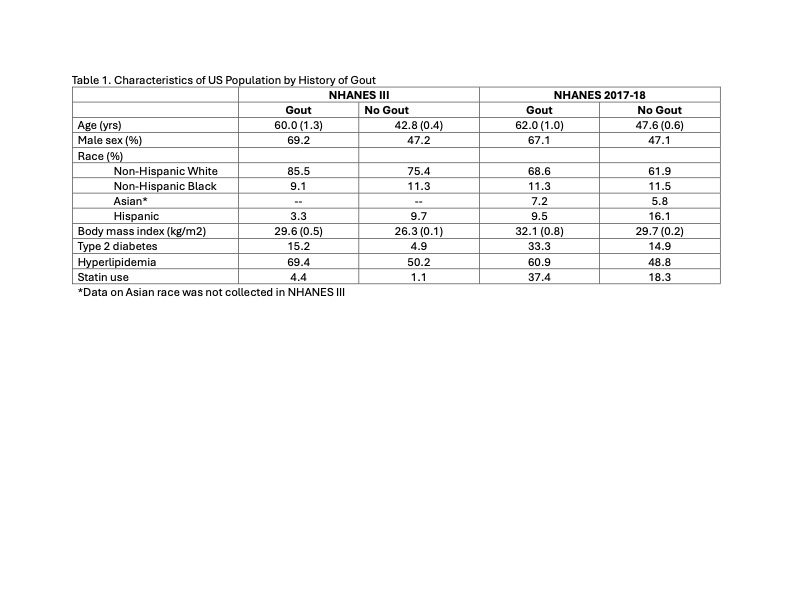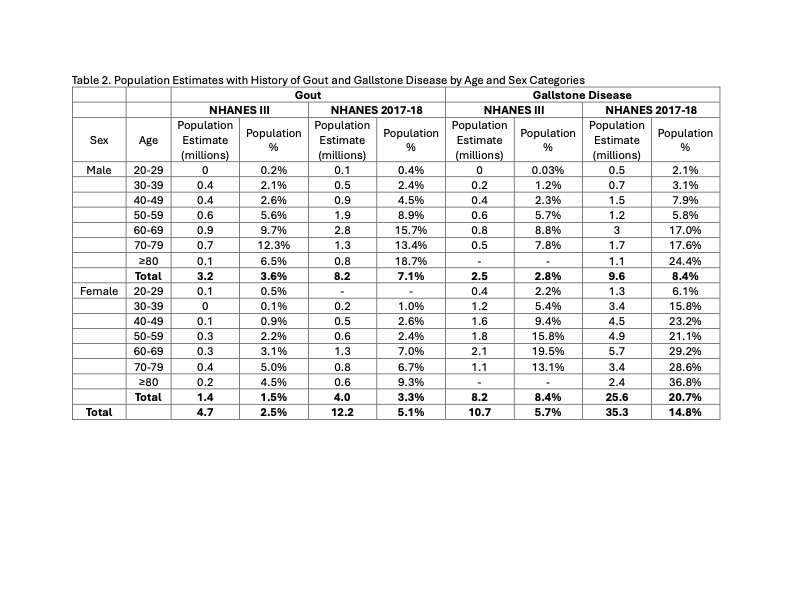Session Information
Session Type: Poster Session A
Session Time: 10:30AM-12:30PM
Background/Purpose: Gout is associated with kidney stones, but its association with gallstone disease is not known. Gout and gallstone disease have several shared risk factors (e.g., obesity, diabetes), but the strong female predilection in gallstone disease contrasts with the strong male predilection in gout. Novel medications to treat common risk factor conditions for gout (e.g., semaglutide and tirzepatide) are associated with gallstone disease. Therefore, we sought to determine and quantify the association between gout and gallstone diseases using nationally representative US data.
Methods: We used data from the National Health and Nutrition Examination Survey (NHANES) III (1988-94) and NHANES 2017-18 in which self-reported data on history of gout, gallstones, or gallstone surgery were ascertained. Covariates included age, sex, race, ethnicity, body mass index, comorbid type 2 diabetes and hyperlipidemia, and use of statins. All statistical analyses were performed using survey commands of SAS to adjust for clusters and strata of the complex sample design and to incorporate sample weights to generate estimates for the total civilian, noninstitutionalized US population. We examined the characteristics of the US population by history of gout in both NHANES III and NHANES 2017-18. We calculated the national prevalence and population estimates of gout and gallstone disease according to sex and age during both time periods. We then performed logistic regression analyses to calculate the odds ratio (OR) for gallstone disease while adjusting for covariates using combined data from NHANES III and NHANES 2017-18.
Results: In both NHANES cycles, individuals with gout were older, more likely to be male, and have a higher prevalence of obesity, type 2 diabetes, and hyperlipidemia compared to those without gout (Table 1). The prevalence of gout increased from 2.5% (4.7 million) in NHANES III to 5.1% (12.2 million) in NHANES 2017-18 (Table 2, Figure 1). Similarly, the prevalence of gallstone disease increased from 5.7% (10.7 million) to 14.8% (35.3 million) (Table 2, Figure 1). The prevalence of gout among males was higher than that of females in all age categories, while the prevalence of gallstone disease was higher among females than males (Table 2). In 2017-18, there were an estimated 3.3 million US adults with both gout and gallstone disease (Figure 1). Individuals with gout had 2.0-fold higher odds of having gallbladder disease in the age- and sex-adjusted model (OR 2.0, 95% CI, 1.5 to 2.8); this association attenuated but remained significant in the fully adjusted multivariable model with an OR of 1.6 (95% CI, 1.1 to 2.2).
Conclusion: Both gout and gallstone disease are highly prevalent conditions among US adults, with increasing prevalence over time. Notably, 3.3 million US adults suffer from both gout and gallstone disease, and individuals with gout have 1.6-fold higher odds of having gallstone disease. Additional studies are required to better understand the association between gout and gallstone disease.
To cite this abstract in AMA style:
Yokose C, Jiang B, McCormick N, Rai S, Choi H. The Association Between Gout and Gallstone Disease: US General Population Analysis [abstract]. Arthritis Rheumatol. 2024; 76 (suppl 9). https://acrabstracts.org/abstract/the-association-between-gout-and-gallstone-disease-us-general-population-analysis/. Accessed .« Back to ACR Convergence 2024
ACR Meeting Abstracts - https://acrabstracts.org/abstract/the-association-between-gout-and-gallstone-disease-us-general-population-analysis/



